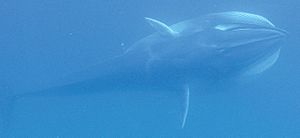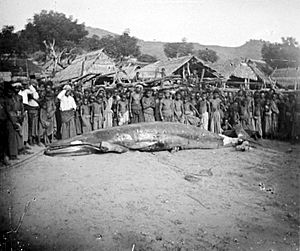Omura's whale facts for kids
Quick facts for kids Omura's whale |
|
|---|---|
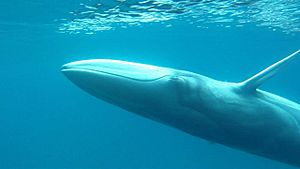 |
|
| Omura's whale | |
| Conservation status | |
| Scientific classification | |
| Genus: |
Balaenoptera
|
| Species: |
omurai
|
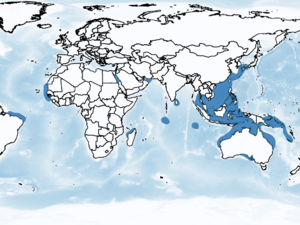 |
|
The Omura's whale or dwarf fin whale (Balaenoptera omurai) is a type of rorqual (a group of large baleen whales). Not much was known about this whale for a long time. Before it was officially named, people sometimes called it a small version of Bryde's whale. Its common name and scientific name honor a Japanese whale scientist named Hideo Omura.
Scientists officially described this whale in the journal Nature in 2003. Three Japanese scientists studied its body shape and mitochondrial DNA (a type of genetic material). They looked at nine whales. Eight of these were caught by Japanese research ships in the late 1970s. The ninth was an adult female found in 1998 near Tsunoshima, an island in the Sea of Japan. Later, more genetic studies proved that Omura's whale is its own unique species. It seems to be an early branch from the rorqual family tree, possibly related to the much larger blue whale.
Contents
Discovery and Naming
In 1976 and 1978, some whales were caught that seemed different. They were smaller than regular Bryde's whales. Scientists Shiro Wada and Kenichi Numachi noticed their unique baleen plates (filter-like plates in their mouths) and their small size. They also saw that these whales looked like fin whales because of their colors. They thought these might be a new species.
However, there wasn't enough detailed study of their bones at first. So, the International Whaling Commission decided to call them just a "small-form Bryde's whale." But later, a DNA study by Hideyoshi Yoshida and Hidehiro Kato in 1999 supported the idea that they were a separate species.
The mystery was finally solved in 1998. A whale died after hitting a fishing boat near Tsunoshima, Japan. Tadasu Yamada, a scientist from the National Science Museum, Tokyo, examined it. This whale looked very much like the ones caught in the 1970s. This time, scientists could study its entire skeleton.
By looking at its outside appearance, bones, and DNA, Wada, Masayuki Oishi, and Yamada officially described Balaenoptera omurai in 2003. To thank the people of Tsunoshima who helped with the whale, it was given the Japanese name Tsunoshima kujira, which means "Horn Island whale."
The very first Omura's whale used for its official description was an 11.03-meter (about 36-foot) adult female. It was found stranded at Tsunoshima in 1998. Scientists collected its full skeleton, baleen plates, and tissue samples. Eight other whales, caught by Japanese research ships in the 1970s, were also used to help describe the species.
What Omura's Whales Look Like
Omura's whales have some special features in their bones that help tell them apart from other whales like Bryde's and Eden's whales. For example, they have a certain shape in their upper jaw bones and unique small holes in their skull. They also have 53 bones in their spine (vertebrae). Like other whales in their group, they have four "fingers" in their flippers.
Their appearance is similar to the larger fin whale. Both have a dark gray lower left jaw and a white patch on the right side. They also have a white mark on their back and white on the inside of their pectoral fins. Like fin whales, their baleen plates (which they use to filter food) also have uneven colors.
Omura's whales have a curved dorsal fin (the fin on their back). This fin is smaller and less upright than those of Bryde's or sei whales. They usually have one main ridge on their snout, while Bryde's whales have three. They also have many grooves (45 to 95) on their belly that stretch past their belly button.
The baleen plates of Omura's whales are shorter and wider than those of other whales in their family. They have between 181 and 246 pairs of these plates.
Whales seen in some areas, like off New Caledonia, had many scars from cookiecutter shark bites. This shows they travel into deep ocean waters.
Size
Omura's whale is one of the smaller rorquals. Only the two types of minke whales are smaller. Female Omura's whales found by Japanese whalers were about 10.1 to 11.5 meters (33 to 37.7 feet) long. Males were a bit smaller, from 9.6 to 10.0 meters (31.5 to 32.8 feet) long.
Some young Omura's whales found stranded in Taiwan and Thailand were much smaller, from 4.3 to 10 meters (14 to 32.8 feet) long. Calves (baby whales) seen off Madagascar were estimated to be between 3 and 5 meters (9.8 to 16.4 feet) long.
Behavior and Diet
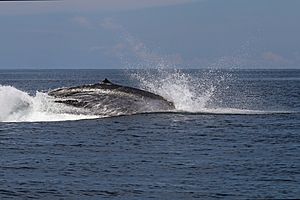
Scientists don't know a lot about how Omura's whales behave or what they eat. When they breathe out, their blow is low and spreads out. Their dorsal fin usually doesn't show until their head has gone back under the water. They also don't lift their tail flukes out of the water when they dive.
They have been seen "lunge feeding," which means they swim fast with their mouths open to catch food. They have also been seen jumping out of the water (breaching). Off Madagascar, they usually travel alone or in small groups of about one or two whales. Sometimes, larger groups of up to a dozen whales can be seen together.
The Omura's whales studied in the Solomon Sea had only krill (tiny shrimp-like creatures) in their stomachs. Whales in Madagascar have been seen eating a specific type of krill called Pseudeuphausia latifrons.
Song
Omura's whales make special sounds, or "songs." These songs are low-pitched, between 15 and 50 Hz, and last about 9.2 seconds. Sometimes, a shorter, clearer sound follows the song. These songs repeat every two to three minutes and can go on for many hours. Scientists have heard these songs all year round off northwest Madagascar. They are most active from late October to late January and again from late May to late June.
Movements
In 2016, scientists put satellite tags on four Omura's whales off northwest Madagascar. The tags stayed on for about 42 days. The whales traveled an average of 2,530 kilometers (about 1,570 miles). But they stayed within a small area of the coast, about 230 to 405 kilometers (143 to 251 miles) wide. This shows they prefer to stay in coastal waters, especially over the continental shelf, and rarely go into very deep ocean areas.
Where Omura's Whales Live
Omura's whales are found in the Indo-Pacific and Atlantic Oceans. They mostly live in waters over the continental shelf (the shallow part of the ocean near land). They are usually found in tropical areas, between 35° North and 35° South latitude.
Their known range includes:
- Southern Japan
- South Korea
- China
- Taiwan
- Hong Kong
- The Philippines
- Vietnam
- Malaysia
- Thailand
- Indonesia
- The Cocos (Keeling) Islands
- The Andaman Islands
- Australia (Western Australia, South Australia, Queensland)
- The Solomon Islands
- New Caledonia
- Sri Lanka
- The Chagos Archipelago
- Iran (Strait of Hormuz)
- Egypt (northern Red Sea)
- Northwestern Madagascar
- Mauritania
- Brazil
- Near the Saint Peter and Saint Paul Archipelago.
Sightings
In 1999 and 2000, a small, unknown whale was seen many times in Komodo National Park. It looked like a fin whale but was smaller and had only one ridge on its snout. At first, scientists thought it was a "pygmy Bryde's whale." Later, DNA tests showed it was actually an Omura's whale.
Between 2011 and 2014, scientists saw Omura's whales 44 times off northwestern Madagascar. Most of these sightings were in shallow shelf waters, not in very deep or very shallow coastal areas. In 2017, the first confirmed live sightings of Omura's whale were made off Taiwan and Sri Lanka.
Threats to Omura's Whales
Caught by Hunters
As early as the late 1800s, people on islands like Pamilacan Island in the Philippines started hunting whales. They would chase whales in small boats and use hooks or harpoons to catch them. After the whale was caught, it was brought to shore to be butchered and eaten. Hunters from Pamilacan alone caught 10 to 20 whales each year.
Scientists first thought these whales were Bryde's whales. But later studies of their skulls and DNA showed that 24 out of 28 skulls from the Bohol Sea were actually from Omura's whales. This means that many of the whales caught by these local hunters were Omura's whales.
Old records also show that some whales caught in Indonesia between 1915 and 1944 were likely Omura's whales.
Caught by Accident
Omura's whales can also get caught by accident in fishing nets. This is called "bycatch." Several Omura's whales have been found caught in fishing gear in Japan and South Korea. For example, a young male whale was caught in a herring net in Thailand in 2011. A whale seen off Sri Lanka in 2017 also had a scar that looked like it had been tangled in fishing gear.
Ship Strikes
Sometimes, whales are hit by ships. This is called a "ship strike." The very first Omura's whale used for its official description, the one found off Tsunoshima in 1998, was a victim of a ship strike. Another whale was found on the front of a ship in Manila Bay.
Protecting Omura's Whales
Omura's whale is listed in Appendix II of the Convention on the Conservation of Migratory Species of Wild Animals. This means that its numbers are not ideal, and it would greatly benefit from countries working together to protect it.
The whale is also covered by the Memorandum of Understanding for the Conservation of Cetaceans and Their Habitats in the Pacific Islands Region. This agreement helps protect whales and their homes in the Pacific Islands.
See also
 In Spanish: Rorcual de Omura para niños
In Spanish: Rorcual de Omura para niños
- List of cetaceans
- Baleen whale




